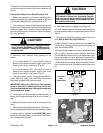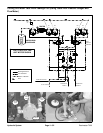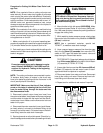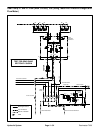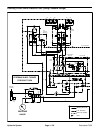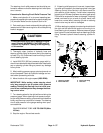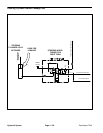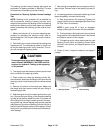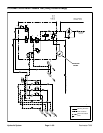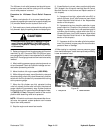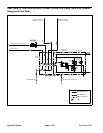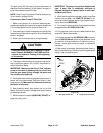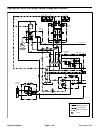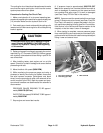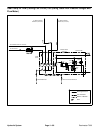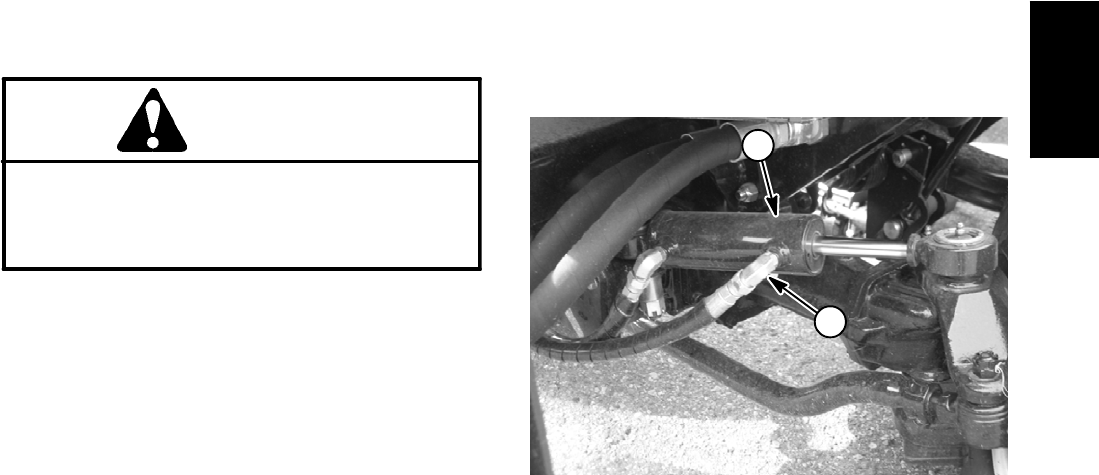
Reelmaster 7000 Hydraulic SystemPage 4 -- 59
The steering cylinder internal leakage test should be
performed if a steering problem is identified. This test
will determine if the steering cylinder is faulty.
Procedure for Steering Cylinder Internal Leakage
Test
NOTE: Steering circuit operation will be affected by
rear tire pressure, binding of steering cylinder, extra
weightonthevehicleand/or bindingofrearaxlesteering
components. Make sure that these items are checked
before proceeding with steering cylinder internal leak-
age test.
1. Make sure hydraulic oil is at normal operating tem-
perature by operating the machine under load for
approximately ten (10) minutes. Make sure the hydrau-
lic tank is full.
2. Parkmachine onalevel surfacewith thecuttingunits
lowered and off. Turn the steering wheel for a right turn
so that the steering cylinder is fully extended. Turn en-
gine off and apply the parking brake.
CAUTION
Prevent personal injury and/or damage to equip-
ment. Read all WARNINGS, CAUTIONS and Pre-
cautions for Hydraulic Testing at the beginning
of this section.
3. Thoroughlycleantheareaaroundthehydraulichose
at the rod end of the steering cylinder.
4. Place a drain pan under the steering cylinder. Re-
movehydraulic hosefromthefittingon therodend ofthe
steering cylinder.Install a steel plug in thedisconnected
hose.
5. Remove all hydraulic oil from drain pan. Make sure
that empty drain pan remains under the open fitting of
the steering cylinder.
6. Withthe engine off,turn the steering wheel fora right
turn. Observe the open fitting on the extended steering
cylinder as the steering wheel is turned. If oil comes out
of the fitting while turning the steering wheel, the steer-
ing cylinder has internal leakage and must be repaired
(see Steering Cylinder and Steering Cylinder Service in
the Service and Repairs section of this chapter). Check
drain pan for any evidence of oil that would indicate cyl-
inder leakage.
7. After testing is completed, remove plug from the hy-
draulic hose. Connect hose to the steering cylinder fit-
ting.
8. If a steering problem exists andthe steering cylinder
tested acceptably, consider the following:
A. Gear pump section P3 (steering, lift/lower and
chargecircuits) iswornordamaged (seeGearPump
P3 Flow Test in this section).
NOTE: If gear pump P3 is worn or damaged,
charge, steering and lift circuits will all be affected.
B. Theflowdivider inthefandrivecontrol manifoldis
faulty (see Fan Drive Manifold Service inthe Service
and Repairs section of this chapter).
C. The steering control valve requires service (see
Steering Control Valve and Steering Control Valve
Service in the Service and Repairs section of this
chapter).
9. Check oil level in hydraulic reservoir and adjust if
needed.
1. Steering cylinder 2. Rod end fitting
Figure 44
1
2
Hydraulic
System



